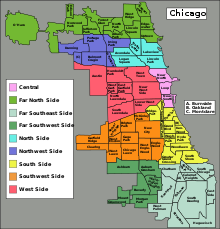
Back Anexo:Áreas comunitarias de Chicago Spanish Secteurs communautaires de Chicago French Chicago közigazgatása Hungarian コミュニティ・エリア (シカゴ) Japanese Áreas comunitárias de Chicago Portuguese Список районов Чикаго Russian Gradske oblasti Čikaga Serbian

The city of Chicago is divided into 77 community areas for statistical and planning purposes. Census data and other statistics are tied to the areas, which serve as the basis for a variety of urban planning initiatives on both the local and regional levels. The areas' boundaries do not generally change, allowing comparisons of statistics across time. The areas are distinct from but related to the more numerous neighborhoods of Chicago; an area often corresponds to a neighborhood or encompasses several neighborhoods, but the areas do not always correspond to popular conceptions of the neighborhoods due to a number of factors including historical evolution and choices made by the creators of the areas. As of 2020[update], Near North Side is the most populous of the areas with over 105,000 residents, while Burnside is the least populous with just over 2,500. Other geographical divisions of Chicago exist, such as the "sides" with origin in the 3 branches of the Chicago River, the 50 wards of the Chicago City Council which undergo redistricting based in population movements, and the parishes of the Roman Catholic Church.
The Social Science Research Committee at the University of Chicago defined the community areas in the 1920s based on neighborhoods or groups of related neighborhoods within the city. In this effort it was led by sociologists Robert E. Park and Ernest Burgess, who believed that physical contingencies created areas that would inevitably form a common identity. Except for the addition of two areas (O'Hare from land annexed by the city in 1956 and Edgewater's separation from Uptown in 1980) and peripheral expansions due to minor annexations, the areas' boundaries have never been revised to reflect change but instead have been kept stable. The areas have become a part of the culture of Chicago, contributing to its perception as a "city of neighborhoods" and breaking it down into smaller regions for easier analysis and local planning. Nevertheless, Park's and Burgess's ideas on the inevitability of physically related areas forming a common bond have been questioned, and the unchanging nature of the areas has at times been seen as analytically problematic with major subsequent changes in some of the areas' urban landscapes, such as the construction of expressways.